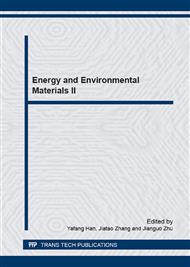p.441
p.447
p.458
p.464
p.470
p.476
p.483
p.488
p.498
Potentials for Denox in Chinese Cement Industry with the Life Cycle Assessment Method
Abstract:
To explore NOx mitigation strategies in Chinese cement industry systematically, a material flow analysis was developed. The realistic output of cement production in China were identified and quantified. The inventory data of Chinese cement production were selected without denitration technology applications at that time. Then the life cycle impact assessment (LCIA) results were calculated with the principal of ISO 14040 and ISO 14044 of Life Cycle Assessment. The impact categories of global warming potential (GWP), acidification potential (AP), eutrophication potential (EP), photochemical oxidant formation potential (POCP), and human toxicity potential (HTP) were used to calculate environmental impact. The results showed that the NOx emission was the major environmental damages and the following was CO2 emission. This argument disagreed with the view that CO2 emission was the major contributor of environmental load. The reason is that the NOx emission is far over the international level due to few denitration technology applications. In the assumption of selective non-catalytic reduction (SNCR) technology applications, there is still large emission mitigation potential according to the target scenario analysis. The application of selective catalytic reduction (SCR) technology with higher deNOx efficiency and the roadmap of deNOx of Chinese cement industry were also discussed. The SNCR technology with the auxiliary of SCR development over the coming decades will be decisive for the roadmaps of Chinese cement industry to reach deeper NOx emission cuts.
Info:
Periodical:
Pages:
470-475
Citation:
Online since:
March 2015
Authors:
Price:
Сopyright:
© 2015 Trans Tech Publications Ltd. All Rights Reserved
Share:
Citation:


